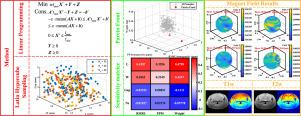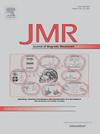3t MRI系统的被动摆振性能:不同磁场分布下摆振参数的影响。
IF 1.9
3区 化学
Q3 BIOCHEMICAL RESEARCH METHODS
引用次数: 0
摘要
本研究提出了一种简单且计算效率高的方法来优化被动调光槽的结构设计参数,旨在改善不同应用环境下无低温3t / 200mm超导磁体的磁场均匀性。该方法将拉丁超立方体采样(LHS)与基于线性规划(LP)的优化框架相结合,利用300多个采样配置来探索高维设计空间,同时坚持结构约束。该方法应用于四种不同的磁体,每个磁体都具有独特的磁场不均匀性模式,这是由制造和组装变化引起的。通过谐波分解,确定了系统特定的灵敏度,并使用针对每个磁体量身定制的被动摆振策略有效地减轻了灵敏度。优化过程显著改善了磁场均匀性,磁体1至4的峰对峰(PP)值分别提高到12.16、10.04、27.28和54.59 ppm。相应的,均方根误差(RMSE)均匀性提高到2.28、1.98、5.07和9.68 ppm。此外,所有谐波项的幅度降低了1-2个数量级,抑制水平超过90%,同时最大限度地减少了铁磁材料的使用。现场验证了所提出策略的实际可行性:磁体1成功提供了高质量的动物MRI成像,具有优异的信噪比(SNRs),其余磁体目前正在进行最后的校准和交付。这项工作为精确和资源高效的被动摆振提供了一个强大的可扩展优化框架,为未来磁体的设计、定制和部署在生物医学和工业应用中提供了有价值的指导。本文章由计算机程序翻译,如有差异,请以英文原文为准。

Passive shimming performance in 3 T MRI systems: Influence of shim parameters under varying magnet field distributions
This study proposes a simple and computationally efficient method to optimize the structural design parameters of passive shimming slots, aiming to improve magnetic field homogeneity in cryogen-free 3 T/200 mm superconducting magnets used across diverse application environments. The proposed method combines Latin Hypercube Sampling (LHS), utilizing over 300 sampled configurations, with a linear programming (LP)-based optimization framework to explore high-dimensional design spaces while adhering to structural constraints. The method was applied to four distinct magnets, each characterized by unique field inhomogeneity patterns resulting from manufacturing and assembly variations. Through harmonic decomposition, system-specific sensitivities were identified and effectively mitigated using customized passive shimming strategies tailored to each magnet. The optimization process achieved substantial improvements in magnetic field homogeneity, with peak-to-peak (PP) values enhanced to 12.16, 10.04, 27.28, and 54.59 parts per million (ppm) for Magnets 1 to 4, respectively. Correspondingly, the root-mean-square error (RMSE) homogeneity improved to 2.28, 1.98, 5.07, and 9.68 ppm. Furthermore, the magnitudes of all harmonic terms were reduced by 1-2 orders of magnitude, with suppression levels exceeding 90%, while minimizing the use of ferromagnetic materials. The practical feasibility of the proposed strategy was validated on-site: Magnet 1 successfully delivered high-quality animal MRI imaging with excellent signal-to-noise ratios (SNRs), and the remaining magnets are currently undergoing final calibration and delivery. This work presents a robust and scalable optimization framework for precise and resource-efficient passive shimming, offering valuable guidance for future magnet design, customization, and deployment in biomedical and industrial applications.
求助全文
通过发布文献求助,成功后即可免费获取论文全文。
去求助
来源期刊
CiteScore
3.80
自引率
13.60%
发文量
150
审稿时长
69 days
期刊介绍:
The Journal of Magnetic Resonance presents original technical and scientific papers in all aspects of magnetic resonance, including nuclear magnetic resonance spectroscopy (NMR) of solids and liquids, electron spin/paramagnetic resonance (EPR), in vivo magnetic resonance imaging (MRI) and spectroscopy (MRS), nuclear quadrupole resonance (NQR) and magnetic resonance phenomena at nearly zero fields or in combination with optics. The Journal''s main aims include deepening the physical principles underlying all these spectroscopies, publishing significant theoretical and experimental results leading to spectral and spatial progress in these areas, and opening new MR-based applications in chemistry, biology and medicine. The Journal also seeks descriptions of novel apparatuses, new experimental protocols, and new procedures of data analysis and interpretation - including computational and quantum-mechanical methods - capable of advancing MR spectroscopy and imaging.

 求助内容:
求助内容: 应助结果提醒方式:
应助结果提醒方式:


